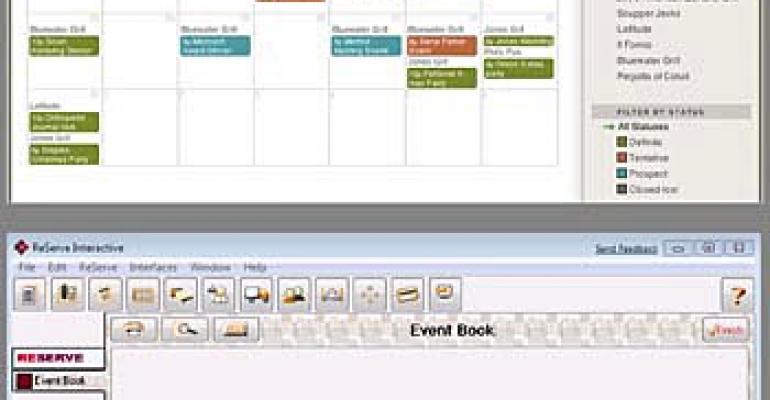Accommodating private dining events is an increasingly popular way for restaurants to offset falling traffic in other areas of their business, though managing these affairs remains a cumbersome task for many.
The answer to this dilemma, some chains and independents indicate, can be found in different flavors of hosted, Web-accessible event and catering management software. Such technology products increasingly are termed software-as-a-service, or SaaS, offerings.
In one approach, such operators as the four-unit B.B. King's Blues Club group, owned by Beale Street Blues Co. of Memphis, Tenn., are tapping an application for catering and event management accessed across the Internet using a thin-client application. For ease of use, the small footprint thin-client program is launched from a desktop icon. The 89-unit, full-service McCormick & Schmick's Seafood Restaurants Inc. of Portland, Ore., also uses this technology from ReServe Interactive of Delafield, Wis.
ReServe Interactive hosts its application on its own servers, charging clients, on average, approximately $1,800 per unit, per year. The fee, which varies in accordance with the number of user "seats" licensed for each location, includes maintenance; training and data customization expenses are billed separately.
Adesire to enhance event and catering management efficiencies spurred B.B. King's to install the ReServe Interactive offering last year, according to Audrey Joyner, director of sales and marketing. The operator employs the software to track event room availability and bookings and to generate and modify event-related proposals, contracts, invoices and setup/service arrangements. Using the program, B.B. King's staff also can produce reports, forecast revenue and maintain a client database, she says.
Closing deals is easier using ReServe Interactive's software, Joyner indicates, as it provides immediate access to room availability information and lets users alter proposals or other arrangements on the fly and quickly pass them along to prospective clients.
B.B. King's initially tested the system in one unit, doubling event sales over a six-month period. The software was launched subsequently at the other three clubs and is producing comparable results, Joyner says.
Jeff Skeele, McCormick & Schmick's senior vice president of operations, says ReServe Interactive's hosted product was favored by his company because it did not want to buy additional hardware or grapple with software integration or configuration. Another selling point, he says, was the software's ability to anticipate and automate successive steps in the event and catering management process, from the client inquiry stage to the final execution.
"Having process-driven software in place means it's impossible to 'forget' a step that has to take place and keeps everyone on the same page," resulting in better customer service and increased repeat event business, Skeele reports. He adds that the chain did not experience any training and deployment challenges; onsite training was handled by the vendor as part of the package.
ReServe Interactive's technology is used by 102 restaurant accounts, including steakhouse operators PRG and The Palm. Its thin-client architecture differentiates it from software served up using a Web browser. The ability to open multiple windows and multitask from within the management program is an advantage the thin-client approach has over browser-based setups, the vendor says.
But browser-based technology appears to suit just fine 35 operations deploying Tripleseat, a Web-accessed event and catering management application from Tripleseat Software of Boston. Operators can test-drive the system for free for 30 days, then pay a flat fee of $89 per unit, per month to use the product. Users access the system through amazon.com, on which it is hosted. Each restaurant is assigned its own URL, screen name and password.
Tripleseat's application is event driven, automatically generating event-specific "to-do" and task lists for event managers and their coworkers. Information entered into one screen automatically gets ported to others. For example, booking information added to a calendar page also flows directly into the booking database.
The Tripleseat software features event and arrangement tracking and generates proposals, contracts, invoices and reports. As does ReServe Interactive's product, Tripleseat has an event book centralization feature that allows event managers to simultaneously view space availability at all units within a chain.
Boston-based Davio's Northern Italian Steakhouse Inc. implemented Tripleseat in its Boston and Philadelphia restaurants, as well as in the company's Avila Mediterranean restaurant, also located in Boston.
"Quite simply, we were looking for a very cost-effective solution that would allow us to centralize our party bookings," Patricia LaBella, director of sales, says of the late September 2008 deployment of Tripleseat. "In the past, we would have customers call and ask for a certain date, and if it wasn't available, we would have to put them on 'hold' to check to see if one of our other locations had space. It wasn't that uncommon for some people to say 'thanks anyway,' and hang up to go look elsewhere for a venue. Although I can't quantify it, we're seeing a lot less of that now."
LaBella indicates that she favors a browser-based platform for a number of reasons. "We didn't want to deal with updates or downloading, which aren't a factor with the system we chose," she states. "And training was a non-issue."
Eleanor Greene, catering manager at West On Centre restaurant in Roxbury, Mass., says that generating and tracking event bookings via the Tripleseat system helps to salvage business that might otherwise be lost because of scheduling conflicts. The system, she adds, affords her flexibility that "just wasn't possible" with manual event and catering management methods.
"In this business, it's not unusual to propose a menu to a client and have that client come back and ask for something different in terms of price, components and the like," Greene explains. "Before, it would take hours to make the changes. Now, I can make the adjustments and have new paperwork ready within 20 minutes. Because it's Web-based, we can also take care of requests from wherever we are — at home or in one of the restaurants. You can't do that with a drawer full of paper files."





